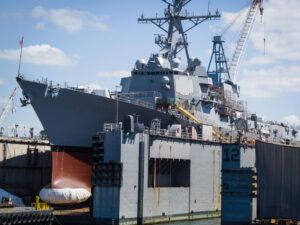A recent report from The Moscow Times stated that a Russian sailor from the Black Sea Fleet was arrested for plotting to blow up a Russian warship with “precision-guided munitions” being used against targets in Ukraine.
That vessel was almost certainly one of the two Admiral Grigorovich class frigates currently operating in the Black Sea. In the wake of the loss of the air defense cruiser Moskva last April to Ukrainian Neptune cruise missiles, these ships, Admiral Makarov and Admiral Essen are the only two large Russian surface warships in the Black Sea Fleet capable of precision-guided munitions (Kaliber cruise missile) launches although the Fleet’s Bunyan and Karakut class missile corvettes also have this capability.
The Russian Navy has a long history of mutinies including the attempted defection of the frigate Storozhevoy in 1975 in the Baltic Sea during the Cold War, and the more famous mutiny and takeover of the battleship Potemkin, which sparked the abortive 1905 Russian revolution and was the inspiration for the communist propaganda film about the mutiny by Soviet filmmaker Sergei Eisenstein in 1925.
Given the unpopularity of the Ukraine War, and the attempted revolt/protest of Wagner group Russian mercenaries, could the Black Sea Fleet by ripe for another grand and embarrassing naval mutiny?
Past Russian naval mutinies
Russian sailors have always been a more independent lot than Russian soldiers and have staged multiple mutinies across the tsarist and communist eras. The most famous of these remains the takeover of the Black Sea Fleet battleship Potemkin in June 1905.
Revolutionary cells had been organized in Russia for some time in response to the harsh Tsarist state and the disastrous outcome of the Russo-Japanese war that saw two Russian fleets annihilated by the Japanese and thousands of Russian sailors lost. On the Potemkin, sailors initially rebelled against rotten meat being used for the ship’s midday meal.
After the ship’s executive officer threatened to shoot the protesting seamen (something completely against Russian naval regulations of the time,) rebellious members of the crew led by engineer quartermaster Afanasii Matiushenko took arms and began murdering the ship’s officers including the captain and the chief surgeon, who had claimed the meat was fit for human consumption.
A sailor wounded in the gunfire exchange, gunner Vakulenchuk, died of his wounds and became a martyr for the cause. Other Black Sea Fleet ships refused to fire on the mutinous warship, and after a week of trying to support a larger, but failed uprising in Odessa, the Potemkin sailed to Constanza, Romania, then to Feodosiya in Crimea and finally back to Constanza, pursued by Russian naval forces throughout.
Finally, with provisions and fuel denied by the Romanian government, the mutineers scuttled the battleship in shallow water and came ashore in Romania. Most were later hunted down and hanged, including Matiushenko, who briefly fled to the U.S. and worked in a Singer Sewing machine factory in New York before returning to Russian to resume revolutionary activity. He was captured and hanged in Sevastopol in 1907.
Russian sailors even mutinied against communist governments. After helping to start the Russian revolution from the cruiser Aurora that was purported to have fired the first shots of the communist takeover, Russian sailors grew restless under Lenin’s rule. In March 1921, a Ukrainian clerk, Stephen Petrichenko from the battleship Petropavlovsk, staged a revolt of sailors in the Baltic Fleet port of Kronstadt, claiming that the “dictatorship of the Proletariat” was now resident in Moscow and not with the people.
Some 1,500 sailors manning over 135 guns joined the revolt and it took 25,000 of war komisar Leon Trotsky’s troops to overcome them. Hundreds were killed. Petrichenko escaped to Finland but was eventually extradited to the Soviet Union and died in prison in 1945. Senior political fleet officer Pavel Dybenko took charge of Kronstadt, only to be later killed in Stalin’s 1937 purge.
A mutiny that was inspiration for Tom Clancy
The most recent Russian naval mutiny was inspiration of one of the greatest fictional naval works of the Cold War era. In 1975 the political officer of the Baltic Sea Krivak class frigate Storozhevoy, Lt. Com. Valery Sablin was disgusted by the need for reform in the decaying Soviet state of Leonid Brezhnev.
He locked up the captain of the ship on 7 November, and in the chaos and drunkenness that accompanied the celebration of the Bolshevik November 1917 revolution, Sablin put to sea with the hope of reaching Swedish territorial waters and from there he might broadcast reform messages. One loyal sailor got ashore and informed Baltic Sea fleet leaders, who sent dozens of ships and aircraft in pursuit. After strafing and bombing the ship, the captain of Storozhevoy escaped his prison on the ship and captured the rebellious political officer after shooting him in the leg. Most of the crew escaped punishment, but Sablin was executed for treason in 1976.
The story later made its way into Western intelligence and ended up in a Naval Postgraduate School master’s thesis read by a struggling insurance salesmen and budding writer named Tom Clancy. Clancy made it about a submarine, and the Hunt for Red October became an indelible part of Cold War naval literature and film.
The spark that could light off another rebellion
One rebellious sailor does not constitute a mutiny, but other factors could drive the Black Sea Fleet again into mutiny. The Black Sea Fleet has performed poorly in the Ukraine war, as its flagship that was expected to survive multiple cruise missile hits was apparently abandoned by the crew after two such weapons struck and with little if any attempt at damage control.
Ukraine’s missile and drone attacks have secured a degree of sea denial and Russia’s surface ships rarely venture close enough to the Ukrainian littoral to influence the ground war. Sevastopol is a naval ghost town of sorts with much of the Black Sea Fleet having fled to eastern ports like Novorossiysk to avoid Ukrainian drone attacks.
Russia’s amphibious ships never staged a landing of any consequence on the Ukrainian coast despite being reinforced with more ships before the conflict. Only the Russian submarine force remains fully effective and for now untouchable by the Ukraine military. While it appears that the Black Sea Fleet is mustering some ships to potentially harass ships engaged in moving Ukraine grain, only small, corvette-sized warships have been observed at sea while the larger Russian frigates that have been targeted by Ukrainian unmanned boats remain out of the fight.
Enforced idleness during a war where other forces are fighting and dying has historically been poor for the morale of idle units. The Wagner group protest/rebellion of Yevgeny Prigozhin ended without incident, but a naval revolt with missile-armed warships could be a different matter.
Potemkin fired on Odessa while under mutineer control, and while it did not hit any target of value it was enough to send local authorities into hiding in more secure locations. Do not underestimate the damage to the Putin government that could be done during another Black Sea naval mutiny.







